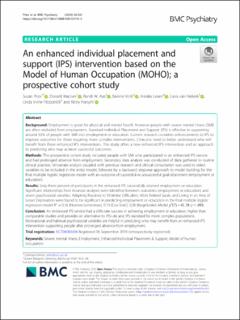| dc.contributor.author | Prior, Susan | |
| dc.contributor.author | Maciver, Donald | |
| dc.contributor.author | Aas, Randi Wågø | |
| dc.contributor.author | Kirsh, Bonnie | |
| dc.contributor.author | Lexen, Annika | |
| dc.contributor.author | Van Niekerk, Lana | |
| dc.contributor.author | Irvine Fitzpatrick, Linda | |
| dc.contributor.author | Forsyth, Kirsty | |
| dc.date.accessioned | 2021-03-01T09:59:22Z | |
| dc.date.available | 2021-03-01T09:59:22Z | |
| dc.date.created | 2020-09-02T13:02:49Z | |
| dc.date.issued | 2020-07 | |
| dc.identifier.citation | Prior, S., Maciver, D., Aas, R.W., et al. (2020) An enhanced individual placement and support (IPS) intervention based on the Model of Human Occupation (MOHO); a prospective cohort study. BMC Psychiatry, 20, https://doi.org/10.1186/s12888-020-02745-3 | en_US |
| dc.identifier.issn | 1471-244X | |
| dc.identifier.uri | https://hdl.handle.net/11250/2730860 | |
| dc.description.abstract | Background
Employment is good for physical and mental health, however people with severe mental illness (SMI) are often excluded from employment. Standard Individual Placement and Support (IPS) is effective in supporting around 55% of people with SMI into employment or education. Current research considers enhancements to IPS to improve outcomes for those requiring more complex interventions. Clinicians need to better understand who will benefit from these enhanced IPS interventions. This study offers a new enhanced IPS intervention and an approach to predicting who may achieve successful outcomes.
Methods
This prospective cohort study included people with SMI who participated in an enhanced IPS service and had prolonged absence from employment. Secondary data analysis was conducted of data gathered in routine clinical practice. Univariate analysis coupled with previous research and clinical consultation was used to select variables to be included in the initial model, followed by a backward stepwise approach to model building for the final multiple logistic regression model with an outcome of successful or unsuccessful goal attainment (employment or education).
Results
Sixty-three percent of participants in the enhanced IPS successfully attained employment or education. Significant relationships from bivariate analyses were identified between outcomes (employment or education) and seven psychosocial variables. Adapting Routines to Minimise Difficulties, Work Related Goals, and Living in an Area of Lesser Deprivation were found to be significant in predicting employment or education in the final multiple logistic regression model R2 = 0.16 (Hosmer-Lemeshow), 0.19 (Cox-Snell), 0.26 (Nagelkerke). Model χ2(7) = 41.38 p < .001.
Conclusion
An enhanced IPS service had a 63% rate success in achieving employment or education, higher than comparable studies and provides an alternative to IPS-Lite and IPS-standard for more complex populations. Motivational and habitual psychosocial variables are helpful in predicting who may benefit from an enhanced IPS intervention supporting people after prolonged absence from employment. | en_US |
| dc.language.iso | eng | en_US |
| dc.publisher | BioMed Central | en_US |
| dc.rights | Navngivelse 4.0 Internasjonal | * |
| dc.rights.uri | http://creativecommons.org/licenses/by/4.0/deed.no | * |
| dc.subject | psykisk helse | en_US |
| dc.subject | mental helse | en_US |
| dc.subject | psykiatri | en_US |
| dc.subject | arbeidsliv | en_US |
| dc.title | An enhanced individual placement and support (IPS) intervention based on the Model of Human Occupation (MOHO); a prospective cohort study | en_US |
| dc.type | Peer reviewed | en_US |
| dc.type | Journal article | en_US |
| dc.description.version | publishedVersion | en_US |
| dc.rights.holder | © The Author(s). | en_US |
| dc.subject.nsi | VDP::Medisinske Fag: 700::Klinisk medisinske fag: 750::Psykiatri, barnepsykiatri: 757 | en_US |
| dc.source.pagenumber | 1-13 | en_US |
| dc.source.volume | 20 | en_US |
| dc.source.journal | BMC Psychiatry | en_US |
| dc.source.issue | 1 | en_US |
| dc.identifier.doi | 10.1186/s12888-020-02745-3 | |
| dc.identifier.cristin | 1826731 | |
| dc.source.articlenumber | 361 | en_US |
| cristin.ispublished | true | |
| cristin.fulltext | original | |
| cristin.qualitycode | 1 | |

